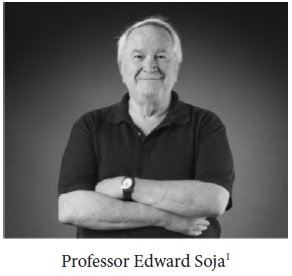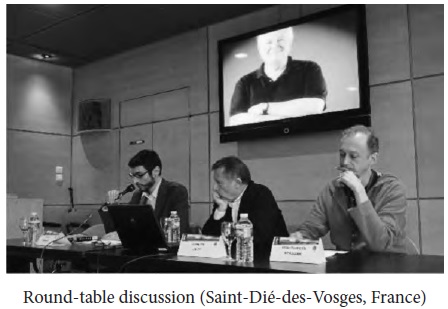Serviços Personalizados
Journal
Artigo
Indicadores
Links relacionados
Compartilhar
Finisterra - Revista Portuguesa de Geografia
versão impressa ISSN 0430-5027
Finisterra no.101 Lisboa abr. 2016
COMENTÁRIO DE AUTOR
Ed Soja, winner of the Vautrin-Lud International Prize 2015 i
Hugh Clout1 1Chair of the Jury for the Vautrin-Lud Prize 2015, Department of Geography, University College London, United Kingdom. E-mail: hughdclout@aol.com

Professor Ed Soja has received the Vautrin-Lud International Prize for Geography in 2015. This award, often known as the ‘Nobel Prize of Geography’, was announced during the 26th international Festival of Geography that was held, as every year, at Saint-Dié-Des-Vosges in eastern France. The prize-winner was selected by the Vautrin-Lud jury, whose members acted on the advice and rankings supplied by almost 150 geographers from all continents of the world. This prize honours the career of a distinguished geographer whose work has been very influential within and beyond our discipline.
Predominantly an urban geographer, planner and “urbanist”, Ed Soja is well known for his “postmodern” approaches which developed after the phase of “quantitative geography” during the 1970s. He is one of the most important North American geographers of his generation, whose work has influenced colleagues and researchers throughout the world. He has written an impressive number of books and scientific articles, some of which have been translated into several languages. His published work has exercised great influence on the development of our discipline, not only in english-speaking countries. Edward William Soja was born in 1940 in the Bronx in New York City. As a young boy, he developed a good understanding of space and time. Some streets in his neighbourhood were dangerous and should be avoided, while others offered Ed and his friends a good place for playing football and other street games; but these conditions were not stable. They varied from hour to hour, and from day to day, according to the movement of vehicles, the flow of pedestrians, and the occurrence of crime. Ed soon assembled his understanding of space, time and society to produce a safe solution. Ed Soja acquired his first degree from Hunter College, in the City University of New York, and then took a Master of Science qualification at the University of Wisconsin. At this time, he was very influenced by the quantitative work of Peter Gould, Vautrin-Lud prize-winner in 1993. Soja undertook his doctoral research at the University of Syracuse, New York State; the topic of his thesis was “Modernization in Kenya”. He spent several months working in archives and libraries in London, before undertaking fieldwork in Kenya which had gained independence in 1964. His thesis was not a classical monograph but rather a quantitative study that was illustrated by many maps that had been prepared, initially, on a computer. Soja insisted that “space matters” for the advancement of geographical knowledge and for explain observed diversity. It is not simply a “container” or “setting” but is an active element in geographical study. His book entitled Modernization in Kenya: a spatial analysis (1968) was well received by geographers, but was criticized by some reviewers drawn from among experts in international development, who expected to find more emphasis on political issues and due reference to Marxism. Then, Soja was appointed to northwestern University, in the northern suburbs of Chicago, where he taught human geography and African studies. With John Paden, he edited a large volume, entitled African Experience (1970) that dealt with thematic aspects of African studies in north American universities. In 1972, he left Northwestern University for the Chair of Urban Planning in the school of architecture and Urban Planning at the University of California, Los Angeles (UCLA). This decision proved to be the turning point in his career. He found that California was not just film making and a fabulous place where dreams came true – the pot of gold at the end of the rainbow – but was also a territory with areas of extreme poverty set alongside neighbourhoods that are among the richest in the whole world. The problems of inequality increased day by day, since Los Angeles was attracting thousands of migrants from Mexico and the countries of South and Central America each year. Of course, California had experienced a period of strong industrial growth during and after the second World War, but by the middle of the 1960s that growth was over. Unemployment was growing in a frightening way, not only among the Black and Latino sections of the population, but also among members of the White working class. In 1965, riots in the Black neighbourhood of Watts had demonstrated the growing seriousness of the problem of socio-economic inequality. Two main problems confronted Professor Soja:– How to explain the great social and spatial contrasts that occurred across the vast territory of greater Los Angeles;
– And how to train young planners to become activists in the management of this metropolis, and thereby improve the everyday life and wider life chances of deprived Californians.
What theories could be called upon to help him in his teaching and research? Soja discovered the works of Henri Lefebvre (notably La Production de l’Espace, 1974), of Michel Foucault, and other specialists of “French Theory”, as it called in the United States. A little later, he accepted feminist approaches after reading the work of bell hooks and others. With greater Los Angeles, in effect the whole of southern California, as his research area, and a theoretical orientation that became more and more sophisticated, he wrote a heap – no, rather a library – of important books over the years. The first was Postmodern Geographies: the reassertion of space in critical social theory (1989). This was a fundamental book of great importance for well informed readers. It dealt with the arguments of Marx, Lefebvre, Foucault, Anthony Giddens, David Harvey and many others. It was aimed at masters and doctoral students, rather than at undergraduates with little exposure to the topic. Despite its complexity, Postmodern Geographies exercised an important influence, not only in our discipline but also in sociology, philosophy and even literature. In the middle years of the 1990s, Soja brought out Thirdspace: journeys to Los Angeles and other real-and-imagined places (1996). In seeking to define “Thirdspace”, he declared: “everything comes together … subjectivity and objectivity, the abstract and the concrete, the real and the imagined, the knowable and the unimaginable, the repetitive and the differential, structure and agency, mind and body, consciousness and the unconscious, the disciplined and the trans-disciplinary, everyday life and unending history” (pp. 56-57). This remarkable collection of factors was casseroled slowly and seasoned with a great deal of imagination. Certainly, Soja drew on the ideas of Lefebvre and Foucault but he also introduced many other approaches, including feminist ones, in his richly argued chapters on Los Angeles and other major cities around the world. In Postmetropolis: critical studies of cities and regions (2000) Soja delivered an impressive “geohistory of urban space” in which he analysed archaeological, historical and geographical work especially in the Middle east and Europe, before returning to Los Angeles and the challenge of deindustrialization and globalization in California, to explore the disappearance of the “known” industrial sector and its replacement by the “little known”, “unknown” or “imagined” in the rapidly developing tertiary and quaternary sectors. In this book, the “time” element appeared vigorously alongside “space”, “theory” and “Los Angeles”. And readers encounter a new, specialized vocabulary, such as “exopolis”, “postmetropolis”, “simcity”, “synekism”, etc. I was especially interested to see Soja’s use of the term “geohistory” that is not widely used among anglo-saxon authors. Seeking Spatial Justice (2010) was Soja’s next book in which our prize-winner invited academics who study geography and town and regional planning to become active in social movements with the aim of combating inequality and promoting “spatial justice”. This was an emphatic return to the idea that “space matters”. Space is not a neutral phenomenon but is a very powerful element in the provision of employment, public transport, schools, hospitals and medical services. Through the pages of this book one encounters the activities of Soja’s own students and doctoral candidates, whose work has been inspired by his own militancy. For him – and for them – urban geography is not only an academic, scientific activity, but is a means for transforming and improving our world. It is an expression of “active geography” and an invitation to apply knowledge to enhance socio-economic conditions in urban space. In his most recent book, My Los Angeles: from urban restructuring to regional urbanization (2014), which must be translated in the plural “Mes Los Angeles”, since the urban agglomeration is not only vast but remarkable diverse and complex, Ed Soja returns in a very personal way to the theories, problems and challenges that have characterized his career. In truth, this text is a much more direct and reader-friendly than his earlier books. Throughout his time at UCLA, Ed Soja has collaborated with colleagues in several disciplines. One thinks of The City: Los Angeles and Urban Theory (1996) that he edited with Allen J. Scott, the Vautrin-Lud prize-winner in 2003. Soja has also worked with numerous doctoral and masters students, and with a wide range of professionals who are concerned with planning Los Angeles and its ever-growing region. In Thirdspace, he expressed his thanks to his students from whom he acknowledged having learned a great deal over the years. Ed Soja is a generous and caring professor who acknowledges the importance of others in the formation and development of his own ideas. His work is very much in the sprit of the 26th International Festival of Geography that was devoted to “Territories of the Imagination: utopia, representation and prospective”. Unfortunately, Professor Soja was unable to be present at Saint-Dié and could not deliver the customary plenary lecture. Instead, his work was explored in an effective round table discussion between Jacques Levy (Lausanne), Olivier Milhaud (Sorbonne-Paris 4) and Jean-François Staszak (Geneva).

NOTAS
iFour weeks after the Vautrin-Lud Prize had been awarded, Professor Ed Soja died in Los Angeles, following a long battle with cancer.














